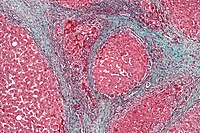
Photo from wikipedia
Bisphenol A (BPA), a phenolic compound, is harmful to humans and animals as its residue in the water threatens multiple organs, especially the kidney. Low selenium (Se) diets are consumed… Click to show full abstract
Bisphenol A (BPA), a phenolic compound, is harmful to humans and animals as its residue in the water threatens multiple organs, especially the kidney. Low selenium (Se) diets are consumed in many regions of the world, and poor Se status has exacerbating effect on toxicity of several environmental chemicals. Here, we described the discovery path of Se deficiency aggravation on autophagy in BPA treated chicken kidney through regulating nitric oxide (NO) and adenosine monophosphate activated protein kinase (AMPK)/mammalian target of rapamycin (mTOR) signaling pathways. The actual dietary Se intake for chickens was 0.30 mg/kg in control group and 0.03 mg/kg in Low‐Se group, and BPA exposure concentration for chickens was 0.05 g/kg. Chicken embryo kidney (CEK) cells were used in vitro and the BPA exposure concentration for CEK cells was 150 nM. We found that BPA significantly increased levels of NO and inducible nitric oxide synthase, activated AMPK/mTOR signaling pathways, thereby triggering p62/LC3/Beclin1 signaling, resulting in formations of autophagosome and autolysosome, and finally stimulating autophagy in the chicken kidney. Additionally, Se deficiency promoted the occurrence of autophagy in BPA‐treated kidneys. Altogether, our findings showed that Se deficiency exacerbates BPA‐induced renal autophagy in chickens via regulation of NO and AMPK/mTOR signaling pathways. These findings will improve our understandings of the mechanisms of nephrotoxicity of BPA and detoxification by Se in chickens. In addition, further work is required to determine if Se status of exposed populations needs to be considered in future epidemiological assessments.
Journal Title: Environmental Toxicology
Year Published: 2022
Link to full text (if available)
Share on Social Media: Sign Up to like & get
recommendations!